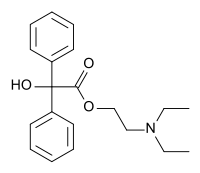Benactyzine
Benactyzine is an anticholinergic drug that was used as an antidepressant in the treatment of depression and associated anxiety before it was pulled from the U.S. market by the FDA due to its ineffectiveness.[1]
 | |
| Clinical data | |
|---|---|
| AHFS/Drugs.com | International Drug Names |
| Routes of administration | Oral |
| ATC code |
|
| Legal status | |
| Legal status |
|
| Identifiers | |
| |
| CAS Number | |
| PubChem CID | |
| DrugBank | |
| ChemSpider | |
| UNII | |
| KEGG | |
| ChEMBL | |
| CompTox Dashboard (EPA) | |
| ECHA InfoCard | 100.005.568 |
| Chemical and physical data | |
| Formula | C20H25NO3 |
| Molar mass | 327.424 g·mol−1 |
| 3D model (JSmol) | |
| |
| |
| | |
Its use for these indications was limited by side effects such as dry mouth and nausea, and at high doses it can cause more severe symptoms such as deliriant and hallucinogenic effects.[1] "Large doses of benactyzine in normal subjects may produce a state resembling the action of mescaline or LSD." [2]
Brand names have included: Suavitil, Phebex, Phobex, Cedad, Cevanol, Deprol, Lucidil, Morcain, Nutinal, Parasan. While there was some tentative evidence of effectiveness when combined with meprobamate, with the medication no longer available it is not clinically important.[3]
History
Benactyzine was brought to market in the US in 1957 by Merck under the tradename, Suavitil.[4]
References
- Shorter, E., Looking backwards: a possible new path for drug discovery in psychopharmacology. Nat Rev Drug Discov 2002, 1 (12), 1003–1006.
- Fisher, Seymour (1959). Child Research In Psychopharmacology (1st ed.). Springfield, Illinois: Charles C Thomas Pub. p. 13.
- DeBattista, Alan F. Schatzberg, Jonathan O. Cole, Charles (2010). Manual of clinical psychopharmacology (7th ed.). Washington, DC: American Psychiatric Pub. p. 423. ISBN 978-1-58562-377-8.
- Smith, Mickey C., PhD. Principles of Pharmaceutical Marketing, Third Edition. 3rd ed. New York: Routledge, 2013. Print. ISBN 978-1-317-94071-5